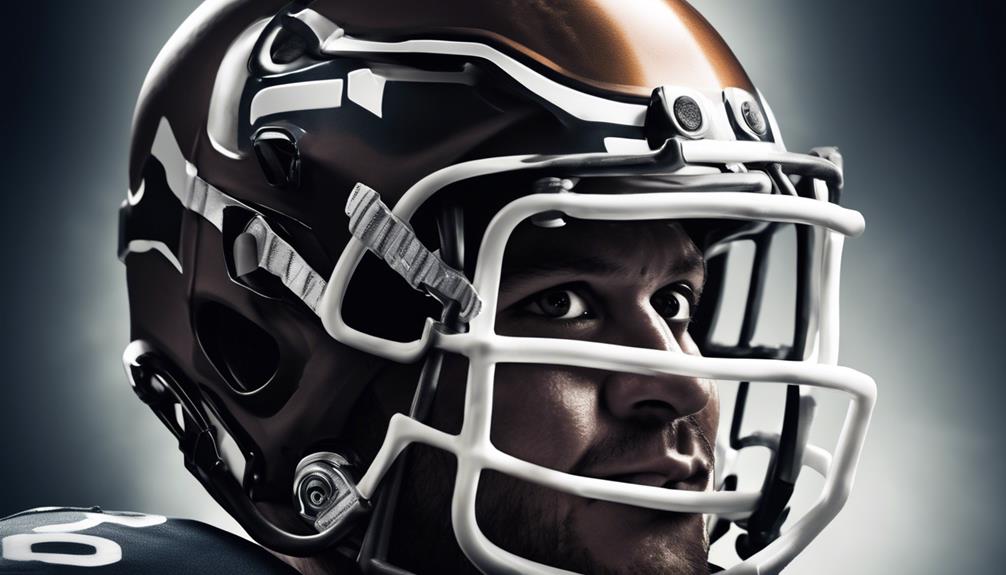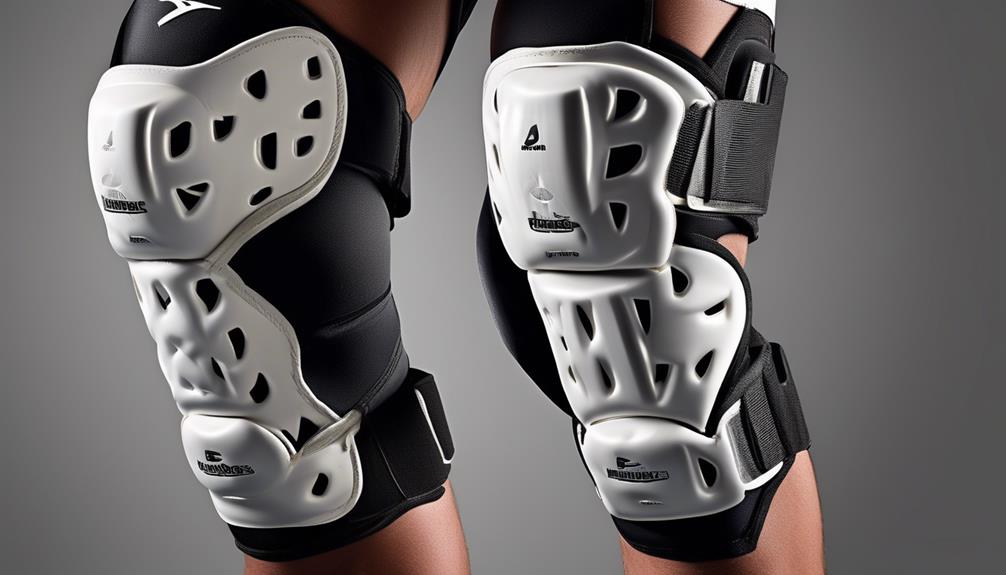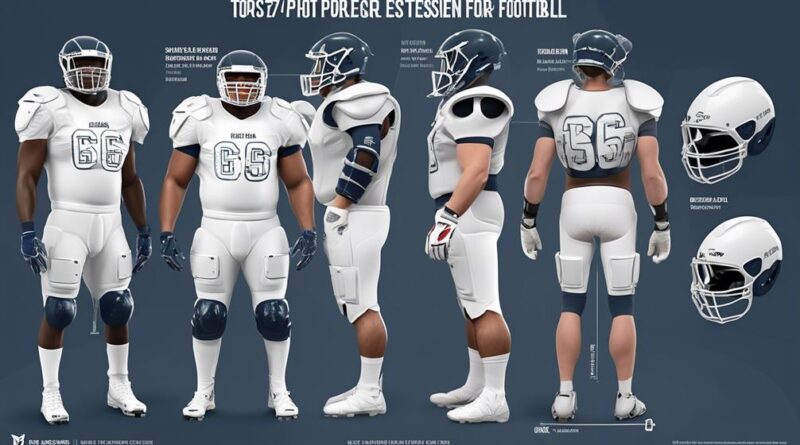Top 7 Football Linemen Protective Gear Essentials
When it comes to the gridiron, the gear you choose as a football lineman plays a pivotal role in protecting you from the hard hits and intense physicality of the game.
From the helmet to the cleats, there are seven essential pieces of protective gear that can make all the difference in keeping you safe and at the top of your game.
But what are these crucial items, and how do they work to safeguard you on the field?
Helmet

When selecting a football helmet, prioritize fit, comfort, and safety. Helmet safety should be your top concern. Make sure the helmet meets the safety standards set by the National Operating Committee on Standards for Athletic Equipment (NOCSAE). Look for the NOCSAE stamp to ensure the helmet is approved for use in football. Additionally, regular maintenance is crucial for ensuring the helmet's safety features remain intact. Inspect the helmet for any cracks or dents, and replace it if any damage is found. Keep the helmet clean and dry to prevent the growth of bacteria and mold, which can compromise its safety.
Helmet technology and innovation have come a long way in improving safety and performance. Look for helmets with advanced impact protection features, such as shock-absorbing padding and reinforced facemasks. Some helmets also come with enhanced ventilation systems to keep you cool during intense gameplay. Consider helmets with customizable fit systems to ensure a snug and secure fit. This not only enhances safety but also improves overall comfort, allowing you to focus on the game without distractions.
Properly maintaining your helmet is essential to ensure its safety features are functioning effectively. Take advantage of advancements in helmet technology and prioritize safety when selecting your football helmet. A well-fitted and properly maintained helmet won't only protect you on the field but also provide the comfort you need to perform at your best.
Shoulder Pads
To ensure optimal protection and performance on the football field, selecting well-fitted and properly maintained shoulder pads is essential. When choosing shoulder pads, it's important to consider the following:
- Proper fit: Shoulder pads should fit snugly to your shoulders and chest without restricting your movement. They should cover the deltoids and extend to the top of the sternum. Ensure that the pads don't impede your ability to raise your arms or bend at the waist, as these movements are crucial in football.
- Material options: Shoulder pads are available in various materials, including foam, plastic, and hybrid options. Foam pads offer lightweight and flexible protection, while plastic pads provide more rigid protection. Hybrid shoulder pads combine the benefits of both materials, offering a balance between flexibility and protection. Consider your position and playing style when choosing the material that best suits your needs.
- Maintenance: Proper maintenance of shoulder pads is essential for their longevity and effectiveness. Regularly inspect the pads for any signs of wear and tear, and clean them according to the manufacturer's instructions. Additionally, ensure that the padding inside the shoulder pads remains intact and doesn't compress over time, as this can affect the level of protection they provide.
- League regulations: Be aware of any specific regulations regarding shoulder pads in your football league. Different leagues may have rules regarding the type and size of shoulder pads allowed, so it's important to ensure that your chosen pads comply with these regulations to avoid any penalties or restrictions during play.
Selecting the right shoulder pads is crucial for protecting yourself on the football field while also maintaining your mobility and performance.
Neck Roll
Selecting the proper neck roll to complement your shoulder pads is essential for maximizing protection and comfort on the football field. The neck roll benefits are plentiful, as they provide crucial support to the neck and help reduce the risk of serious injuries. When choosing a neck roll, it's important to consider the size and shape that best fits your body and playing style. A well-fitted neck roll can help absorb and disperse the impact of collisions, reducing the strain on your neck and upper back.
One of the primary benefits of a neck roll is its ability to stabilize the neck, especially during high-impact plays. By providing support to the neck muscles, a neck roll can help minimize the risk of hyperextension or excessive lateral movement. Additionally, it can serve as a cushion between the helmet and shoulder pads, reducing the strain on the neck and allowing for a more comfortable playing experience.
While neck rolls are a popular choice for many football linemen, there are alternatives to consider. Some players opt for neck collars or extra padding within the shoulder pads to achieve similar levels of support. However, it's essential to carefully assess the level of protection and comfort provided by these alternatives to ensure they meet your specific needs.
Ultimately, the right neck roll can significantly enhance your safety and performance on the field. By reducing the risk of neck injuries and increasing overall comfort, it's a crucial piece of protective gear for any football lineman.
Arm Pads
For optimal protection and flexibility during play, football linemen should ensure they have well-fitted arm pads that complement their shoulder pads. Arm pads are essential for protecting the forearms and elbows from impact and abrasions, providing a crucial layer of defense as linemen engage in physical play on the field.
When choosing arm pads, consider the following:
- Arm Pad Effectiveness: Look for arm pads that offer a balance between protection and mobility. The padding should be dense enough to absorb impact from blocks and tackles, while still allowing for a full range of motion. Test the arm pads to ensure they stay securely in place during vigorous movements.
- Arm Pad Designs: There are various arm pad designs available, including full-arm sleeves and separate elbow and forearm pads. Consider which style best suits your playing position and personal preferences. Full-arm sleeves provide comprehensive coverage, while separate pads may offer a more customized fit.
- Material Quality: Opt for arm pads made from high-quality, durable materials that can withstand the rigors of gameplay. Look for moisture-wicking properties to keep sweat at bay and prevent discomfort during extended periods of wear.
- Fit and Comfort: Proper fit is crucial for both comfort and effectiveness. Ensure that the arm pads are snug but not restrictive, and that they integrate seamlessly with your shoulder pads for uninterrupted protection.
Selecting the right arm pads is a vital aspect of a lineman's protective gear, contributing to both safety and performance on the football field.
Rib Protector
When considering a rib protector for football linemen, prioritize a snug yet flexible fit to ensure both comfort and crucial protection during gameplay. A rib protector is essential for shielding the vulnerable ribcage area from impact during tackles, blocks, and other physical interactions on the field. Look for a rib protector that offers superior impact resistance without compromising on a comfortable fit. The last thing you want is to feel restricted or uncomfortable while trying to protect yourself on the field.
The primary purpose of a rib protector is to minimize the risk of rib injuries, such as fractures or contusions, which can sideline players for an extended period. Therefore, prioritize a rib protector that's designed with high-quality materials that absorb and disperse impact forces effectively. A comfortable fit is crucial for ensuring that the rib protector remains in place and provides consistent protection throughout the game. Look for adjustable straps or customizable features to tailor the fit to your body shape and size.
Beyond impact resistance and a comfortable fit, consider the overall flexibility of the rib protector. As a lineman, you need to maintain agility and mobility while wearing protective gear. Look for a rib protector that allows for a wide range of motion without compromising on its protective capabilities. Prioritizing these essential features will help you select a rib protector that offers the best combination of comfort and crucial protection for your ribcage during intense gameplay.
Hip and Tailbone Pads
As you prioritize protection for your vulnerable areas, such as the ribcage, consider the importance of hip and tailbone pads for maintaining your safety and mobility on the field. These protective gear essentials are crucial for football linemen, providing impact protection and promoting mobility and flexibility while engaging in high-impact plays.
Here are the reasons why hip and tailbone pads are indispensable for your safety and performance:
- Impact Protection: Hip and tailbone pads are specifically designed to absorb and disperse the force of impacts, reducing the risk of serious injuries during tackles, blocks, and falls on the field.
- Mobility and Flexibility: These pads are engineered to offer crucial protection without compromising your range of motion, allowing you to maintain agility and maneuverability as you execute your plays on the line of scrimmage.
- Enhanced Confidence: Wearing hip and tailbone pads can provide you with the confidence to perform at your best, knowing that your vulnerable areas are shielded from potential harm.
- Injury Prevention: By incorporating hip and tailbone pads into your protective gear, you can significantly lower the likelihood of sustaining painful injuries, such as hip pointers and tailbone contusions, which could sideline you from the game.
Investing in high-quality hip and tailbone pads is a proactive measure that can safeguard your well-being and elevate your performance as a football lineman. These protective essentials offer the peace of mind and physical fortification needed to excel in the demanding and physical environment of football.
Knee and Thigh Pads

Ensure your protection and mobility on the football field by prioritizing the use of knee and thigh pads. Proper fitting of knee and thigh pads is crucial for maximizing their protective benefits. These pads should fit securely without limiting your movement or causing discomfort. They're designed to absorb impact and protect your knees and thighs from serious injuries. When choosing knee and thigh pads, opt for ones that provide a snug fit without restricting your range of motion. This will ensure that they stay in place and effectively shield your lower body during intense gameplay.
Injury prevention is a primary goal of wearing knee and thigh pads. These protective gears help reduce the risk of sustaining painful contusions, bruises, and other more severe injuries during tackles, falls, or collisions on the field. By providing an extra layer of cushioning, knee and thigh pads act as a barrier between your body and potential impacts. They're especially crucial for linemen who engage in close physical contact and are more susceptible to direct hits from opposing players. Properly fitted knee and thigh pads offer a layer of defense that's essential for minimizing the impact of physical contact, protecting your joints, muscles, and bones from harm.
When it comes to your safety and performance on the football field, the importance of knee and thigh pads can't be overstated. By ensuring a proper fit and prioritizing injury prevention, you can confidently focus on your game knowing that your lower body is well-protected.
Cleats
To maintain your protection and mobility on the football field, prioritize the use of cleats that provide traction and stability while complementing the functionality of your knee and thigh pads. When selecting cleats, consider the following key factors to ensure optimal performance and protection:
- Traction Technology: Look for cleats that feature advanced traction technology designed to provide maximum grip and stability on the field. Cleats with innovative stud patterns and materials can enhance your ability to push off, change direction, and maintain balance, reducing the risk of slipping or losing traction during crucial plays.
- Performance: Choose cleats that are specifically engineered for linemen, offering the necessary support and performance features to accommodate the demands of your position. Consider factors such as ankle support, cushioning, and overall design to ensure that your cleats can withstand the rigors of line play while optimizing your agility and power.
- Cleat Customization: Explore options for customizing your cleats to achieve a personalized fit and feel. Customizable features such as lacing systems, insole options, and sizing variations can help fine-tune your cleats to match your unique preferences and playing style, ultimately enhancing your comfort and performance on the field.
- Material Durability: Prioritize cleats constructed from durable materials that can withstand the physical demands of football. Look for reinforced stitching, sturdy outsoles, and abrasion-resistant materials to ensure longevity and reliable performance throughout the season.
Frequently Asked Questions
How Do Linemen Need to Adjust Their Protective Gear for Different Playing Conditions, Such as Wet or Muddy Fields?
When playing in wet or muddy fields, you need to adjust your protective gear for the weather conditions. Ensure a proper fit for your equipment to prevent injuries and maintain stability during the game.
Are There Any Specific Recommendations for Linemen With Previous Neck or Shoulder Injuries When Selecting Protective Gear?
When selecting protective gear, especially if you have previous neck or shoulder injuries, consider customized equipment. Look into rehabilitative options for added support and protection. Prioritize your safety and consult with a professional for personalized recommendations.
What Are Some Common Mistakes Linemen Make When Selecting and Wearing Their Protective Gear?
When selecting and wearing protective gear, common mistakes include improper fitting, not adjusting for conditions, and neglecting impact protection. Ensure you get the right size, make adjustments as needed, and prioritize impact absorption.
Are There Any Specific Regulations or Guidelines Regarding the Use of Protective Gear for Linemen at Different Levels of Play, Such as High School Versus College or Professional Football?
Regulations and guidelines vary for linemen protective gear at different levels of play, such as high school, college, and professional football. Properly adjust your gear to suit playing conditions, especially on wet or muddy fields.
Are There Any Emerging Technologies or Advancements in Football Lineman Protective Gear That Players Should Be Aware Of?
There are many emerging technologies and advancements in linemen protective gear. Stay informed about the latest developments to ensure you have the best equipment for safety and performance on the field.
Conclusion
So, make sure you have all the essential lineman protective gear before you hit the field.
Your helmet, shoulder pads, neck roll, arm pads, rib protector, hip and tailbone pads, knee and thigh pads, and cleats are all crucial in keeping you safe and protected during the game.
Don't forget to check and maintain your gear regularly to ensure it's in top condition for every game.
Stay safe out there!
